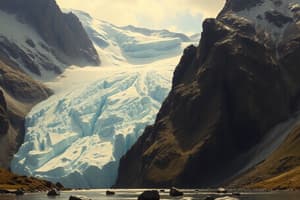Podcast
Questions and Answers
What is a glacier?
What is a glacier?
A large, slow-moving mass of ice formed from compacted layers of snow.
What is the difference between a glacier and an ice sheet?
What is the difference between a glacier and an ice sheet?
An ice sheet is a massive glacier that covers a large area of land, typically more than 50,000 square kilometers. Glaciers are smaller and can be found in mountainous regions.
What is a glacial period?
What is a glacial period?
A glacial period, also known as an ice age, is a time when glaciers expand significantly across the Earth.
What is an interglacial period?
What is an interglacial period?
What is paleoclimate?
What is paleoclimate?
What are Milankovitch cycles?
What are Milankovitch cycles?
What is solar insolation?
What is solar insolation?
What are glacial-interglacial cycles?
What are glacial-interglacial cycles?
What is the ice-albedo effect?
What is the ice-albedo effect?
What is a glacial maximum?
What is a glacial maximum?
What is the Geological Time Scale?
What is the Geological Time Scale?
What was the Paleolithic Era?
What was the Paleolithic Era?
What was the Lower Paleolithic?
What was the Lower Paleolithic?
What was the Middle Paleolithic?
What was the Middle Paleolithic?
The Upper Paleolithic is the final phase of the Paleolithic Era.
The Upper Paleolithic is the final phase of the Paleolithic Era.
What is the Neolithic Pre-Pottery Phase?
What is the Neolithic Pre-Pottery Phase?
Flashcards
Glacier
Glacier
A large, slow-moving mass of ice formed from compacted layers of snow.
Ice Sheet
Ice Sheet
A massive glacier that covers a large area of land - Larger than a glacier/covers more than 50 thousand kilometers.
Glacial Period
Glacial Period
A time during which glaciers expanded significantly across the Earth.
Ice Age
Ice Age
Signup and view all the flashcards
Glacial Advance
Glacial Advance
Signup and view all the flashcards
Glacial Retreat
Glacial Retreat
Signup and view all the flashcards
Interglacial Period
Interglacial Period
Signup and view all the flashcards
Paleoclimate
Paleoclimate
Signup and view all the flashcards
Milankovitch Cycles
Milankovitch Cycles
Signup and view all the flashcards
Solar Insolation
Solar Insolation
Signup and view all the flashcards
Glacial-Interglacial Cycles
Glacial-Interglacial Cycles
Signup and view all the flashcards
Ice-Albedo Effect
Ice-Albedo Effect
Signup and view all the flashcards
Glacial Maximum
Glacial Maximum
Signup and view all the flashcards
Geological Time Scale
Geological Time Scale
Signup and view all the flashcards
Paleolithic Era
Paleolithic Era
Signup and view all the flashcards
Lower Paleolithic
Lower Paleolithic
Signup and view all the flashcards
Middle Paleolithic
Middle Paleolithic
Signup and view all the flashcards
Upper Paleolithic
Upper Paleolithic
Signup and view all the flashcards
Mesolithic Era
Mesolithic Era
Signup and view all the flashcards
Neolithic Era
Neolithic Era
Signup and view all the flashcards
Neolithic Pre-Pottery Phase
Neolithic Pre-Pottery Phase
Signup and view all the flashcards
Neolithic Pottery Phase
Neolithic Pottery Phase
Signup and view all the flashcards
Study Notes
Glacial and Paleolithic Periods
- Glacier: A large, slow-moving mass of ice formed from compacted snow.
- Ice Sheet: A massive glacier covering a large land area (over 50,000 square kilometers).
- Glacial Period: A time when glaciers expand across Earth.
- Ice Age: A period with extensive ice sheets and glaciers.
- Glacial Advance: Glacier growth and expansion.
- Glacial Retreat: Glacier shrinkage and movement back.
- Interglacial Period: A warmer period between glacial periods, with ice sheet retreat.
- Paleoclimate: The study of past climates, including glacial and interglacial periods.
- Milankovitch Cycles: Cyclic changes in Earth's orbit and orientation, influencing climate.
- Solar Insolation: The amount of solar energy Earth receives, varying by latitude and time, influenced by Milankovitch Cycles.
- Glacial-Interglacial Cycles: Repeating advances and retreats of ice sheets, mainly driven by Milankovitch Cycles.
- Ice-Albedo Effect: Ice reflects solar radiation, cooling the Earth; less ice means warming.
- Glacial Maximum: The largest extent of ice sheets during a glacial period.
- Geological Time Scale: A timeline of Earth's history, contextualizing glaciation and interglaciation.
Paleolithic Era
- Paleolithic Era ("Old Stone Age"): From 2.5 million years ago to approximately 10,000 BCE. Early human history, marked by stone tools, hunting/gathering, and early societies.
- Lower Paleolithic: (2.5 million to 300,000 years ago) Earliest phase, characterized by simple stone tools (like hand axes) by early humans like Homo habilis and Homo erectus. Fire control and basic social structures likely emerged.
- Middle Paleolithic: (approximately 300,000 to 40,000 years ago) More advanced stone tools, Homo neanderthalensis and early Homo sapiens; Mousterian tool culture, symbolic behavior possibly, early burials.
- Upper Paleolithic: (roughly 40,000 to 10,000 years ago) Modern humans (Homo sapiens); advanced tools, art (cave paintings, carvings), complex societies, sophisticated hunting, long-distance trade, and structured dwellings.
Later Periods - Mesolithic and Neolithic
- Mesolithic Era ("Middle Stone Age"): Transitional period (roughly 10,000 to 8,000 BCE, varying regionally) from hunting/gathering to early agriculture; more specialized tools like microliths.
- Neolithic Era ("New Stone Age"): From around 10,000 BCE until the Bronze Age, characterized by agriculture, animal domestication, permanent settlements, advancements in pottery and tool-making, social hierarchies, and organized communities.
- Neolithic Pre-Pottery Phase: (circa 10,000-7000 BCE) Early Neolithic, settlement, farming, but no pottery; stone tools, mud-brick structures, agricultural experimentation, and animal domestication.
- Neolithic Pottery Phase: (circa 7000-5000 BCE) Widespread pottery use; functional and decorative purposes; more complex communities, trade, social stratification, and specialized crafts.
Studying That Suits You
Use AI to generate personalized quizzes and flashcards to suit your learning preferences.




